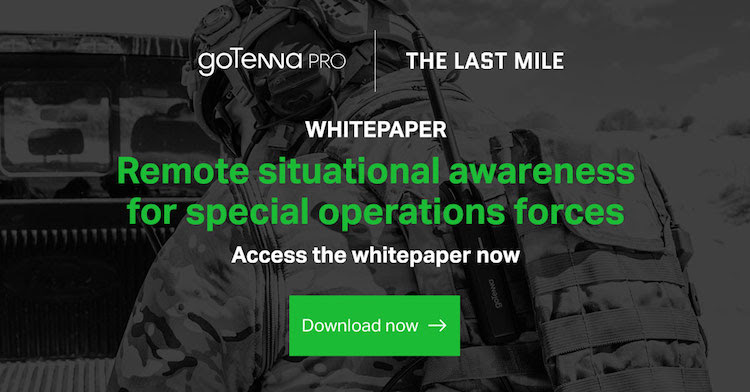Is mobile mesh networking the solution for embassy security?

The United States operates more than 250 embassies and consulates across the globe. Stationed within these embassies and consulates are State Department employees and United States diplomatic personnel responsible for assisting American citizens abroad and playing an essential role in international relations and U.S. foreign affairs.
U.S. ambassadors and diplomats are either chosen directly by the President of the United States or have a significant background in foreign affairs, and these professionals are entrusted with representing the interests of the United States in other countries. Although their work is often confined to the embassy, they often choose to reside in the city where the embassy is located, which allows them to engage actively with the local community and immerse themselves in the host nation.
Ensuring the safety of these key individuals, including their families, who reside and work abroad is of utmost importance. The responsibility for safeguarding American embassies and consulates falls under the jurisdiction of a specialized unit within the U.S. Marine Corps known as the Marine Corps Embassy Security Group. The necessity for such protection arises from a historical pattern of demonstrations and protests surrounding these diplomatic structures, which, in some instances, have escalated into violence. Given this context, the U.S. Marine Corps plays a pivotal role in maintaining the security and integrity of U.S. embassies and consulates, ensuring the safety of personnel and their families in foreign locations.
In challenging situations involving violence or other emergencies, effective communication is crucial for developing collaborative action plans and coordinating activities. Having precise information about the whereabouts of embassy employees and their safety status is vital to minimizing casualties and ensuring the well-being of everyone involved.
Complicating matters, these situations often occur in foreign nations where reliable, available, and secure terrestrial communication networks may be lacking. Fortunately, in such instances, there are off-grid tools that can be utilized. These tools become especially valuable when terrestrial networks are denied, degraded, or deemed untrustworthy. In emergencies, deploying off-grid communication solutions becomes a lifeline, enabling communication even in adverse conditions and ensuring that necessary information can be relayed to safeguard the safety and security of embassy personnel.
How mobile mesh networking can help
Mobile mesh networks are a fast and easy way to create ad hoc, interoperable networks when traditional networks – such as terrestrial and wireless networks – fail. Security teams at U.S. embassies and consulates can leverage the same mobile mesh networks that government agencies such as the U.S. Border Patrol rely on for essential communications and situational awareness capabilities in remote, austere environments.
The use case of leveraging mobile mesh for personnel security and protection is not new. There are well-documented examples of security teams leveraging mobile mesh networks during events to ensure that communications and situational awareness are never lost – even if traditional networks and signals are compromised.
In fact, in a previous article on The Last Mile, personal safety and logistics advising and consulting firm Big Bison Logistics explained how they leverage mobile mesh networks to ensure communications in places where traditional networks cannot reach:
“In one instance, we were asked to provide event security for a small, intimate event that was taking place in a subterranean environment. The thick, concrete floors and structures and the underground nature of the location made it almost impossible to receive a cell signal… Mobile mesh became our primary form of communication, and we were able to stay online.”
Mobile mesh networks can also be leveraged across more extensive areas to cover an entire embassy. Depending on the mobile mesh network configuration, mobile mesh networking devices can also help track embassy personnel operating outside embassy walls.
A passing grade in recent field tests
Last month, goTenna conducted urban field tests designed to gauge the quality and range of a mobile mesh network should it be needed in an emergency around an embassy. During the field test, goTenna Pro X2 radios were installed in numerous disparate urban locations, similar to where embassies would place their mobile mesh networking nodes. These devices created an expansive umbrella of coverage over a large geographic region.
Once established, the mobile mesh network provided real-time updates on the movement of individuals of interest throughout the city. The network – which encompassed an area greater than two miles – was capable of delivering critical communications and situational awareness despite the challenges created by the cityscape and elevation changes inherent in the urban environment.
The test demonstrated the importance of having a mobile mesh network as part of the Primary, Alternate, Contingency, and Emergency (PACE) plan for embassies. This demonstration showed how a mobile mesh network could play an instrumental role in maintaining communication and situational awareness when traditional communications were disrupted in an embassy building or compound, thereby preventing potential tragedies.
Despite the success of the field test in establishing an ad-hoc network capable of covering an entire embassy and its surroundings, valuable insights were gained for further improvement. One challenge encountered was related to line-of-sight issues caused by elevation changes within the city and its landscape. The goTenna team addressed this challenge by strategically placing nodes at higher elevations.
Nevertheless, the urban field test highlighted the feasibility of creating an emergency mobile mesh network with advanced planning and the deployment of relay systems powered by solar energy. The results indicated that such a network could cover a large geographic area, ensuring constant availability. Most notably, with suitable software and accessories, these mobile mesh relay systems could be controlled and maintained remotely, eliminating the need for physical interaction. Placing these nodes at elevated points could effectively establish a broad connectivity umbrella, proving crucial in emergency situations.
This innovative approach holds the promise of addressing unforeseen challenges and significantly enhancing the safety and security of embassy personnel and their families, providing an effective response mechanism in times of crisis.
Click HERE to learn how mobile mesh networking can answer security issues.









No Comment